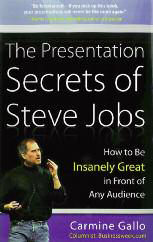Presentation Secrets

You hear it all the time these days: Now is the time to improve all aspects of what you do for a living.
I’ve taken that message to heart and, in striving to upgrade all facets of my work as a watershaper, have come to a somewhat shocking realization: For all of the countless presentations I’ve made to clients, I’ve never taken a critical, disciplined look at that part of my job.
In college, of course, I was forced to make presentations about class projects, but the focus was always on the design and not on the presenting. Indeed, my instructors reinforced the point that it wasn’t how you presented ideas, but instead the merits of the ideas themselves that mattered.
I’ve now come to believe that’s not true. Yes, ideas matter a lot, but there’s also great weight in the way you communicate them.
With that in mind, I recently picked up a copy of The Presentation Secrets of Steve Jobs by Carmine Gallo (McGraw Hill, 2010). Gallo is a columnist for BusinessWeek.com who was assigned to focus on Steve Jobs, the genius behind Apple Computer’s iPOD, iPAD and iPHONE along with other ground-breaking inventions going back to the early 1980s. Most relevant here, Jobs is famous for the presentations he makes to introduce these products – a subject Gallo covers in helpful detail.
At first, one might ask how on earth Jobs’ approach to presentations applies to watershaping. After all, his are meant for mass consumption, while ours are aimed at extremely small groups of people, namely, homeowners in the market for a pool or spa. What I discovered in reading this brilliant book is that not only is his approach relevant, it’s also transforming.
In my work to date, for example, I’ve always focused on a clear, dispassionate exposition of facts – company credentials, basic design principles and heavy doses of technical stuff including structural details, equipment selection and whatever else happened to be on the table that might prompt a decision.
Having read Jobs’ take on the process, however, I’ve come to see that I’ve been off the mark – in some cases, badly so. In contrast to what I’d been doing, he makes a compelling case for selling the impact a product has on people’s lives, pointing out accurately that most will want to know how their purchasing decision will directly affect them. Translating that to watershapes, it’s not about the steel schedule, but about the family experience or the memories to be generated by using our products. That’s a huge shift in focus, to say the least.
Jobs advocates simplicity, brevity and clarity in presentations along with the need to convey enthusiasm and judiciously use supportive video and testimonial material. He stays away from hardcore technical information – something I’ve always relied on – in favor of the more subjective elements of selling. He also advises against using lists of bullet points, suggesting instead that sales presentations should be organized as three major points, with stories and interesting information use to back up each one.
Finally, he strongly recommends practicing and making videotapes you can carefully review to identify areas that need adjustment. This really knocked me on my heels: For all the presentations I’ve made – and as much as I know how important they are to my work and how dynamic they should be – I’ve never, ever rehearsed the process, nor have I ever been advised to do so by anyone in this business.
The book is filled with high-level food for thought, to the point where it struck me that courses on presentation preparation and skills should be a basic part of our education as designers. So read Gallo’s book and consider what it says about your own approach to presentations. My guess is that, like me, you’ll step back and want to rethink things in a big way, almost certainly for the better.
Mike Farley is a landscape designer with more than 20 years of experience and is currently a designer/project manager for Claffey Pools in Southlake, Texas. A graduate of Genesis 3’s Level I Design School, he holds a degree in landscape architecture from Texas Tech University and has worked as a watershaper in both California and Texas.










